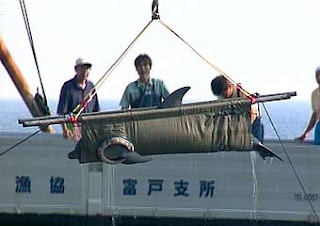 |
| "Knowledge is power." (Design: Pilar Posada 2010) |
Oceanic Defense's Coalition to Stop the Taiji Dolphin Slaughter, initiated in August 2009, has always had one mission and one goal.
Mission: Maintain international attention on dolphin killings while reaching-out to and working with the people of Japan.
Goal: Stop the dolphin drive in Taiji, Japan.
As part of our mission, we reached out to like-minded, social-network-based, grass-roots organizations with Japanese contacts and influence. With Choices for Tomorrow (CFT), we formed a strong working partnership and found common ground with their core philosophy of "Cruelty Free Living and Animal Advocacy". During our campaign last year, they provided invaluable cultural guidance, translation, and leadership to not only Oceanic Defense but also to many other U.S. advocacy groups and activists working in Japan.
This year they are co-sponsoring the Futo Petition to address the re-opening of the dolphin drive/hunt in that town after years of peace in those waters. Significantly, this petition is addressed directly to local town officials including Shizuoka Governor, Ito City Mayor, Chief of the Ito Fishing Cooperative, Chief of the Ito Fishing Cooperative Futo Office, Chairman of Ito City Tourist Association, Chief of Ito City Department of Tourism, Chairman of the Association for the Promotion of Ito Tourism.
The petitions goal was 1000 signatures but has exceeded 2000. Most importantly, however, many of those signatures are by citizens of Japan and many include heart-felt comments that resonant with the rest of the world. Here are a few of those comments (referenced anonymously out of respect for the signers):
_________________________
"While millions of people are starving in the world, in Japan we are dumping millions of tons of food. There is absolutely no need for such Japan to hunt wild mammals for food. From now on, we need culture to let wildlife live instead of killing. Please stop showing off shameful Japan to the world. Please make our culture to be called 'culture to respect life'."
"Please figure out how to ban all this slaughter and become a town known as a respectful tourism-mecca."
"It's not tradition nor culture. It's shameful act."
"Tradition that needs to be protected must be a good tradition. Bad one must be stopped.
"While you were not hunting till reopening this time, you must have had a way to earn living. So it is not like you'll have problem without dolphin hunting. It's not necessary at all! Personally Futo is the place that I got my diving license. I realize it is the popular place for marine sports. With this problem the good image will disappear. I am absolutely against the hunt."
"Cruel."
"It is really disgusting that you tell tourists how cute dolphins are and behind the scene you stab dolphins that could not sold to aquariums. It is the reality that Japan looks very strange to the world. I don't understand why you do it with all these negative impacts."
"I started to consider not to visit Shizuoka anymore"
"I love Futo for diving spots. But if you keep hunting, I will never ever visit there."
"I was shocked to know that Shizuoka as well is the place that dolphin hunting takes place. It is so unfortunate that my image of Shizuoka changed. The snow of Mount Fuji (symbol of Shizuoka) looks to me now red!"
"Frighteningly huge aquarium is under construction in China. Japanese corporation are supporting it. We need to think in case that the aquarium goes bankrupt, for marine animals. Dolphins are victim of money game, not a culture nor tradition and we need to stop."
"While making excuses using the words of tradition and culture, you sell off the wild dolphins to aquariums. You never give a thought about how short the dolphins’ life would be in aquariums with stress. It is as if slave traders. In Japan where food that could be fed to 30 millions people are dumped everyday, killing dolphins is not something to be allowed. Please stop the slaughter. I am shameful as a Japanese."
"With my empathy to the determined spirits of the petition sponsors, I am cooperating on this cause. I am absolutely against dolphin hunting."
And our favorite...
"We won't stop until dolphin hunting will be banned nationwide."
_________________________
What can YOU do?
Please sign and share the Futo Petition. You can also call your local Japanese Consulate or Embassy and tell them that the world is watching and so are their concerned citizens; quote one of your fellow activists from Japan, above.
And, as always, "Educate. Activate." Share what you know with your community, schools, friends and family. Knowledge is power.
_________________________
Samantha Whitcraft
Director, Conservation Biology
Oceanic Defense
Masami Mizuguchi
Co-Founder
Choices for Tomorrow (CFT)
About Oceanic Defense
We are an international non-profit organization with members in over 60 countries, spanning 6 continents with 1 mission; healthy aquatic ecosystems free from human abuse and neglect. Oceanic Defense teaches people to protect our oceans by acting responsibly as consumers and by making smart decisions in our daily lives. Whether we are buying groceries, commuting to work, planning a vacation or advocating within our own communities; each action we take or decision we make either helps or hurts our oceans. We empower people to be part of the solution rather than part of the problem and work together to protect our blue planet.
Join us on Facebook: www.facebook.com/OceanicDefense
Visit our official website: www.oceanicdefense.org
Follow us on Twitter: www.twitter.com/OceanicDefense




